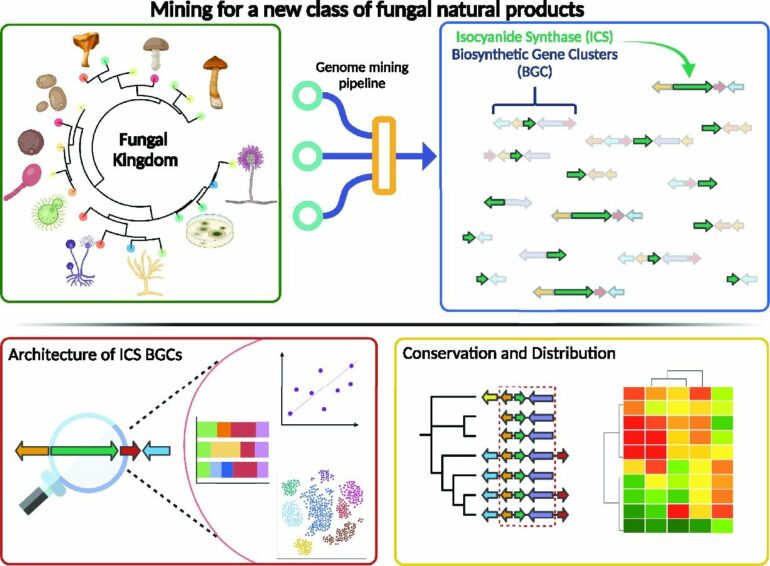A newly described type of chemistry in fungi is both surprisingly common and likely to involve highly reactive enzymes, two traits that make the genes involved useful signposts pointing to a potential treasure trove of biological compounds with medical and chemical applications.
It was also nearly invisible to scientists until now.
In the last 15 years, the hunt for molecules from living organisms—many with promise as drugs, antimicrobial agents, chemical catalysts and even food additives—has relied on computer algorithms trained to search the DNA of bacteria, fungi and plants for genes that produce enzymes known to drive biological processes that result in interesting compounds.
“The field kind of hit a wall in the early 2000s, when the discovery process was to extract things from fungi and see what those extracts did. But we kept rediscovering the same things,” says Grant Nickles, a graduate student in the lab of Nancy Keller, professor of medical Microbiology and immunology. “As we learned more about the genes that make these cool natural products, we designed algorithms that could search for them, find targets and make the process much more efficient.”
That method also hit a wall of sorts because the algorithms only had eyes for certain types of genes.
“The main algorithms made to find natural products work great, but they are focused on genes related to three canonical backbone enzymes,” says Keller. “There have been incremental improvements to those algorithms, but you can only search the same genomes for similar genes so many times before you are, again, rediscovering the same things.”
In 2005, a community of researchers sequenced the genome of Aspergillus fumigatus, a fungus that can infect people with compromised immune systems.
“The first sequence made the hairs on my arms rise,” Keller says. “There were so many clusters of genes of the type that make these backbone enzymes that produce interesting secondary metabolites. I said, ‘Oh! There’s a lot more natural products in fungi than we ever could have guessed.'”
In subsequent research, Keller’s lab uncovered at least one cluster of genes involved in biochemical processes reliant on a backbone enzyme called isocyanide synthase, which is not one of the three “canonical” enzymes known to be common chemical workhorses across bacteria and fungi.
This month, Nickles, Keller and collaborators published a new study in the journal Nucleic Acids Research in which they describe a new algorithm they created to search fungal genomes for the groups of genes, called biosynthetic gene clusters, that synthesize isocyanide to do their work.
“I ran the new algorithm on every fungal genome that I could find on the internet—about 3,300 species—and found that that this is the fifth-largest class of natural products produce by fungi,” Nickles says. “And it was almost completely invisible prior to this study.”
More than 1,300 fungal species have clusters of genes centered on isocyanide chemistry.

Fungi from the genus Fusarium, a threat to cereal grain crops and studied in the lab of USDA plant pathologist Milton Drott, are one of many fungal species newly discovered to include clusters of genes that may produce biological products of use to humans. Karen Broz/ USDA ARS Cereal Disease Laboratory
“It’s so likely these gene clusters are producing something useful to the fungus, or it would be hard to explain why these genes are so common and preserved across the genomes of so many species,” says Milton Drott, co-author of the new study and a former member of Keller’s lab now working as a plant pathologist at the U.S. Department of Agriculture’s Cereal Disease Lab. “What we’ve made is an atlas of those gene clusters. You can start to see interesting patterns there that point to where to look first for significant functions.”
Highest on Keller’s list will be clusters in which the surrounding genes are ones known to tailor enzymes for different purposes or transport them to specific locations or “promoter” genes that flip the switch—on or off—for enzyme production based on conditions in their cells.
“We’re looking for uniqueness,” says Keller, who is co-founder of a company, Terra Bioforge, that makes useful natural products discovered in microbes. “Unique combinations of member genes in a cluster may tell us something about the activity of the structure. But my expectation is that we won’t be the only ones looking.”
The researchers catalogued their fungal findings on a searchable website created by co-author Brandon Oestereicher, meaning many other labs won’t even have to run an algorithmic search—a resource-heavy process that required the help of UW–Madison’s High Throughput Computing Center.
“Labs with a favorite species of fungus—that’s not unusual for people in our field, that they are focused on a species or a narrow range of species—can look their species up on the website and get enough information on the gene clusters to start their own work on isocyanides,” says Drott.
That research may reveal natural compounds with great benefits to society—antibacterial drugs, pesticides, new catalysts for industrial and pharmaceutical chemistry—but the products and purposes of this new biological chemistry are still largely unknown. Drott’s lab studies members of the fungal genus Fusarium that cause blight in grains like barley and wheat. They also have isocyanide biosynthetic gene clusters.
“This is exciting for our work, because these gene clusters may play a role in that pathogenicity, and they may provide an avenue to control the pathogen,” Drott says. “We know so little about what isocyanides can do, though, that we just don’t know what we will find. At least now we know where to start looking.”
More information:
Grant R Nickles et al, Mining for a new class of fungal natural products: the evolution, diversity, and distribution of isocyanide synthase biosynthetic gene clusters, Nucleic Acids Research (2023). DOI: 10.1093/nar/gkad573
Provided by
University of Wisconsin-Madison
Citation:
Fueled by new chemistry, algorithm mines fungi for useful molecules (2023, July 20)



